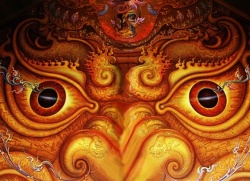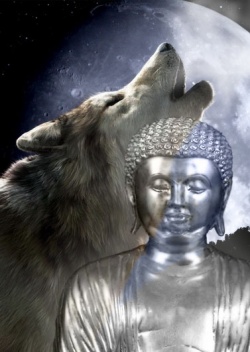Tilakkhana
tilakkhana; Three marks of existence
In Buddhism, the three marks of existence are three characteristics (Pali:
tilakkhaṇa;
Sanskrit:
trilakṣaṇa) shared by all sentient beings, namely impermanence (anicca), dissatisfaction or suffering (dukkha), and non-self (anattā). These three characteristics are mentioned in verses 277, 278 and 279 of the Dhammapada.
Description
The three marks are:
sabbe saṅkhāra aniccā — "all saṅkhāras (conditioned things) are impermanent"
sabbe saṅkhāra dukkhā — "all saṅkhāras are unsatisfactory"
sabbe dhammā anattā — "all dhammas (conditioned or unconditioned things) are not self"
Explanation
Anicca
Main article: Anicca Anicca (Sanskrit anitya) means "inconstancy" or "impermanence". All conditioned things (saṅkhāra) are in a constant state of flux.
The appearance of a thing ceases as it changes from one form to another.
When a leaf falls to the ground and decomposes its relative existence and appearance transform, and its components go into a different form, perhaps a new plant.
Regarding permanence, Buddhism teaches the middle way, avoiding the extreme views of eternalism and nihilism.
Dukkha
Main article: Dukkha
Dukkha (Sanskrit duhkha) means dissatisfaction, "dis-ease", "suffering" "stress". As all things are impermanent, nothing in the physical world or the mind can bring lasting satisfaction. Dukkha is thus the dissatisfaction, suffering or stress experienced by all sentient beings that are not fully enlightened, not free from saṃsāra.
Anatta
Main article: Anatta
Anatta (Sanskrit anatman) means "not self". While anicca and dukkha apply to "all conditioned phenomena" (saṅkhārā), anattā has a wider scope because it applies to "all phenomena" (dhammā) without qualification.
Application
Insight into the three marks of existence can bring an end to suffering (dukkha nirodha or nirodha sacca, the third of the Four Noble Truths).
The Buddha taught that all beings conditioned by causes (saṅkhāra) are impermanent (anicca) and suffering (dukkha) and that not-self (anattā) characterises all dhammas, meaning there is no "I" "me" or "mine" in either the conditioned or the unconditioned (i.e. nibbāna).
The central figure of Buddhism, Siddhārtha Gautama (Pali: Siddhattha Gotama) is believed to have achieved Nirvana (Pali: nibbāna) and awakening after much meditation (bhāvanā), thus becoming the Buddha Shakyamuni.
With the faculty of wisdom (paññā) the Buddha directly perceived that all conditioned phenomena are marked by these three characteristics.


